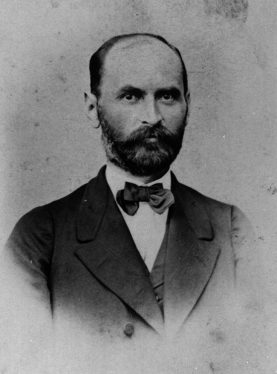The Year of Academician Đura Daničić
The Serbian Academy of Sciences and Arts is commemorating the Year of Academician Đura Daničić (born Đurađ Popović, 6 April 1825, Novi Sad – 7 November 1882, Zagreb), who marked Serbian philology of the second half of the 19th century.
Daničić completed five grades at the Serbian Orthodox Gymnasium in Novi Sad before continuing his education in Pozsony (now Bratislava). In 1844, he began studying law in Pest and continued his studies in Vienna the following year. It was in Vienna that he met Vuk Karadžić and became an enthusiastic advocate of Karadžić’s Serbian language and orthography reform. Abandoning his law studies in 1846, Daničić turned to Slavic philology, working closely with Franz Miklosich.
He departed from Vienna in 1856 when he got the job of the librarian of the National Library in Belgrade. Between 1859 and 1865, he served as a professor of literary theory, philology, and literary history at the Belgrade Lyceum, later known as the Great School. Due to a conflict with educational administrative authorities in 1865, he left his professorship and transferred to the Postal Unit of the Ministry of Internal Affairs. In 1866 he moved to Zagreb, where he was named the first secretary of the Yugoslav Academy of Sciences and Arts. At the invitation of the Minister of Education Stojan Novaković, he returned to Belgrade in 1873 and took over the leading role of the Serbian Department at the Great School. Four years later, he went to Zagreb again, where he passed away in 1882. He was buried in Belgrade.
In 1849, Đ. Daničić became a member of the Society of Serbian Letters and served as its secretary from 1857 to 1861. He was elected a full member of the Serbian Learned Society in 1869 and later became its president in 1878. He was also a member of the Russian Academy of Sciences from 1864.
Through a polemic study Rat za srpski jezik i pravopis [The War for the Serbian Language and Orthography] published in 1847, Daničić introduced scientific argumentation into Serbian philological critique and contributed to Vuk Karadžić’s reform’s triumph. He signed the study with his pseudonym, Đ. Daničić, which he continued to use in subsequent works. With his work, he immeasurably contributed to the construction of Serbian literary language.
In 1850, he published Mala srpska gramatika [Little Serbian Grammar] while its second, somewhat changed and extended edition titled Oblici srpskog jezika [The Forms of the Serbian Language] was published in 1863. He worked together with Vuk on the second edition of the Serbian Dictionary published in 1852, and it was due to him that the marking of the four-accented system of the Serbian literary language was completed in this edition.
Daničić’s work on Serbian accents, published in the edition Slavische Bibliothek (1851), Glasnik DSS (1856−1859) and Rad JAZU (1869−1872), was published by Milan Rešetar in 1925 under the title Srpski akcenti [Serbian Accents]. In his work Srpska sintaksa [Serbian Syntax] (1858), Daničić provided a comprehensive description of the case system of the Serbian language. His translations also play an important role in the codification of the Vuk’s type of literary language. Notable among these are Pripovijetke iz Starog i Novog zavjeta [Stories from the Old and New Testaments] (1850), Pisma o službi božijoj u pravoslavnoj crkvi [Letters on the Service of God in the Orthodox Church] by A. N. Muraviev (1854), Istorija srpskoga naroda [History of the Serbian People] by A. Majkov (1858) and Old Testament (1864−1868).
Daničić dedicated his life to studying the Serbian linguistic and literary heritage as well as to lexicography. He compiled Rječnik iz književnih starina srpskih I−III [Dictionary of Serbian Literary Antiquities] (volumes I−III, 1863−1864), the first historical dictionary of the Serbian language, encompassing both vernacular and literary vocabulary. He was the initiator and first editor of Rječnika hrvatskoga ili srpskoga jezika JAZU [JAZU Dictionary of the Croatian or Serbian Language] (1880‒1976). He published old Serbian manuscripts, including Život Svetoga Save [Life of Saint Sava] by Theodosius (1860), Nikoljsko jevanđelje [the Gospel of St. Nicholas] (1864), Život svetoga Simeuna i svetoga Save [Life of Saint Simeon and Saint Sava] by Domentian (1865), Živote kraljeva i arhiepiskopa srpskih [Lives of Serbian Kings and Archbishops] by Archbishop Danilo II (1866), and Hvalov rukopis [Hval’s Codex] (1871). The book Istorija oblika srpskoga ili hrvatskoga jezika do svršetka XVII vijeka [History of the Forms of the Serbian or Croatian Language to the End of the 17th Century] (1874), dedicated to historical morphology, remains unparalleled to this day.
A versatile and tireless researcher in the field of synchrony and diachrony of the Serbian language and the founder of several scientific disciplines in Serbian philology, Daničić’s contributions have left an enduring legacy in the history of Serbian science and culture.

